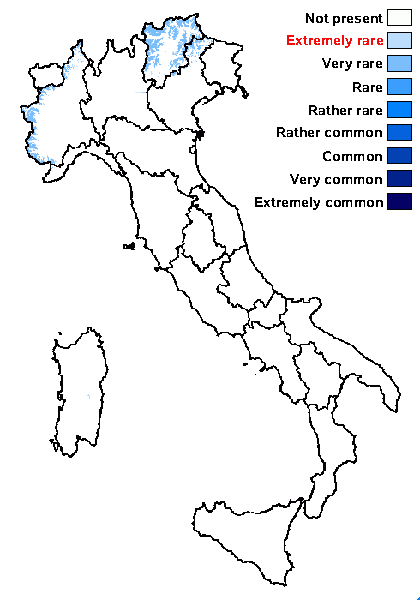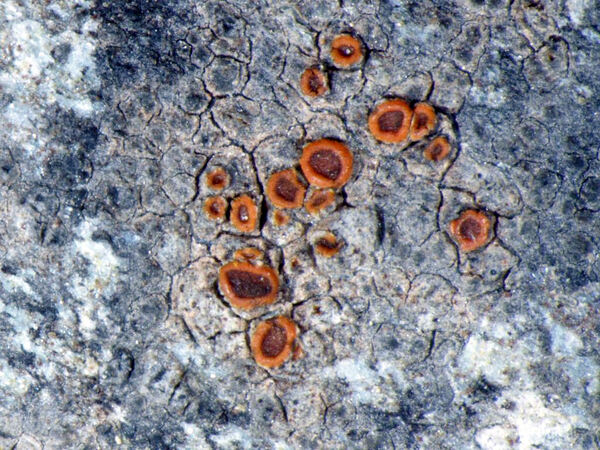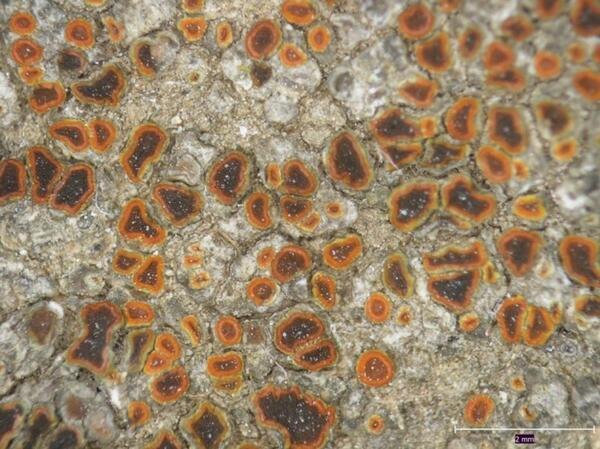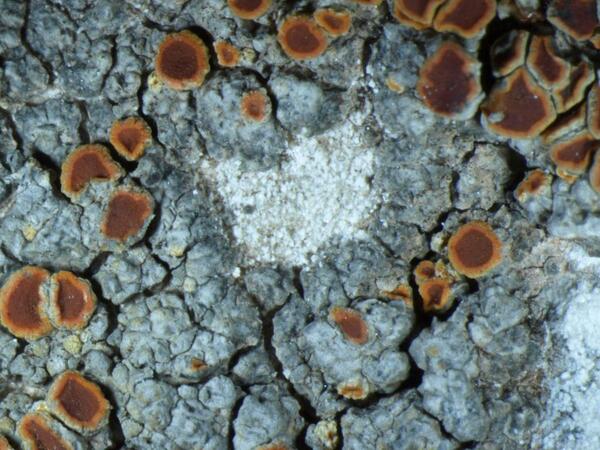Kuettlingeria percrocata (Arnold) I.V. Frolov, Vondrák & Arup
in Frolov & al., J. Syst. Evol. 59, 3: 468, 2020. Basionym: Blastenia percrocata Arnold - Flora, 67: 309, 1884.
Synonyms: Callopisma percrocatum (Arnold) Jatta; Caloplaca percrocata (Arnold) J. Steiner
Distribution: N - Ven (Frolov & al. 2020), TAA (Vondrák 2008, Vondrák & al. 2008, Nascimbene & al. 2022), Piem (TSB 34342). Lig. C - Tosc, Sar.
Description: Thallus crustose, episubstratic, areolate, whitish grey to dark grey, often with a bluish or brownish tinge, well-delimited, sometimes with a thin, dark grey prothallus, the areoles irregular, uneven, flat to convex, up to 3 mm wide. Cortex paraplectenchymatous, 15-35 µm thick, obscured by colourless crystals insoluble in K and soluble in N, K– or K+ faintly violet, N+ faintly violet; medulla with many crystals. Apothecia zeorine, often in groups, 0.4-1.5 mm across, round, angular or irregular in outline, at first semi-immersed but son becoming sessile, with a flat, brownish orange to brownish red disc contrasting with a paler, yellowish orange, thick, raised proper margin; thalline margin pale yellow, soon excluded and finally poorly visible. Thalline exciple ecorticate in lower part, or with an indistinct, up to 20 µm thick cortex; proper exciple of radiating hyphae; epithecium orange-brown K+ purple-red, C+ purple; hymenium colourless 90-120 µm high; paraphyses sparingly branched in upper part, the apical cells up to 5(-6.5) µm wide; hypothecium colourless, with oil droplets. Asci 8-spored, cylindrical-clavate, functionally unitunicate, apically thickened with a broad internal beak, the inner part of apex and external cap I+ blue, Teloschistes-type. Ascospores 2-celled, polarilocular, hyaline, ellipsoid, 14-18(-20) x 6-10(-12) µm, the equatorial thickening (“septum”) 3-6 µm (c. 1/3 of spore length). Pycnidia grey in upper part, the wall K+ violet. Conidia ellipsoid, 2.5-4 x 1.1.5 µm. Photobiont chlorococcoid. Spot tests: thallus K- or K+ violet, C- or C+ violet, KC-, P-; apothecia K+ purple-red, C+ purple. Chemistry: thallus with the Sedifolia-grey pigment and chloroemodin; apothecia with chlorinated anthraquinones ( 7‐Cl‐emodin and fragilin). Note: on base-rich and lime-containing siliceous rocks above treeline. The identity of Mediterranean samples (e.g. those from Sardinia) is dubious, and all records from Southern Italy reported by Nimis (1993: 180) are not accepted here.
Growth form: Crustose
Substrata: rocks
Photobiont: green algae other than Trentepohlia
Reproductive strategy: mainly sexual
Commonnes-rarity: (info)
Alpine belt: very rare
Subalpine belt: extremely rare
Oromediterranean belt: extremely rare
Montane belt: absent
Submediterranean belt: absent
Padanian area: absent
Humid submediterranean belt: absent
Humid mediterranean belt: absent
Dry mediterranean belt: absent

Predictive model
Herbarium samples
Growth form: Crustose
Substrata: rocks
Photobiont: green algae other than Trentepohlia
Reproductive strategy: mainly sexual
Commonnes-rarity: (info)
Alpine belt: very rare
Subalpine belt: extremely rare
Oromediterranean belt: extremely rare
Montane belt: absent
Submediterranean belt: absent
Padanian area: absent
Humid submediterranean belt: absent
Humid mediterranean belt: absent
Dry mediterranean belt: absent

Predictive model
| Herbarium samples |
 INDEX FUNGORUM
INDEX FUNGORUM
 GBIF
GBIF
 DOLICHENS
DOLICHENS






